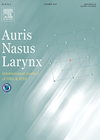
Journal Reviews
Otolith malfunction can be a cause of orthostatic dizziness
This prospective study evaluated otolith function with vestibular evoked myogenic potentials (VEMPs) and subjective visual vertical / horizontal (SVH) tests in 50 adults with normal hearing between the ages of 18 and 50 years. The authors hypothesised that there are...
The never-ending vertigo
The authors comment on the Barany Society guidelines for bilateral vestibulopathy (BV). This is one of the murky entities of vestibulogy. By definition, patients will eventually lose vestibular function and don’t experience any vertigo. However, some patients still get recurrent...
Cochlear implantation in enlarged vestibular aqueduct patients
In this systematic review, the authors describe the complications and outcomes of cochlear implantation in patients with enlarged vestibular aqueduct (EVA). The authors reviewed five major databases and included 4035 patients from 34 studies. Of these, 853 patients (21.14%) had...
Impact of vestibular rehabilitation on patients with peripheral vestibular disorders
Vestibular rehabilitation is a widely used treatment for vestibular dysfunction. It can improve dizziness, fall risk, balance, and emotional status. However, some patients do not get benefit from vestibular rehabilitation. In this study, the authors assessed the impact of dizziness...
Lateral skull base surgery using the endoscope
Endoscopic lateral skull base surgery could be performed via less invasive techniques due to wide panoramic visualisation of the operative field. With less invasive techniques, patients have been shown to require shorter recovery time and reduced postoperative pain. In this...
Hearing outcomes after retrosigmoid resection of smaller vestibular schwannomas are better
The authors reviewed published literature reporting hearing outcomes in patients after retrosigmoid (RS) resection of vestibular schwannoma (VS). Aggregate hearing preservation of 31% and 35% under fixed and random models respectively was observed in the 2034 patients meeting eligibility criteria...
Is there a need for magnetic resonance imaging six-month post-radiosurgery for vestibular schwannoma?
With advances in imaging and radiation technologies, small, slowly growing vestibular schwannomas (VS) are treated primarily with either observation or stereotactic radiosurgery (SRS). Routine magnetic resonance (MRI) scans with gadolinium are obtained six months and one year after SRS in...
Treatment outcomes and dose rate effects following gamma knife stereotactic radiosurgery for vestibular schwannomas
Gamma knife radiosurgery (GKRS) is one of the definitive stereotactic radiotherapy treatment modalities for vestibular schwannoma (VS) management. Its efficacy depends on the cobalt-60 source which has a half-life of 5.26 years. According to the study authors, the actual rate...
Does the season affect the diagnosis of vestibular disorders?
There are mixed results in the literature regarding seasonal variation in the presentation of various peripheral vestibular disorders. In this large population study involving over 20,000 patients recruited from 116 ENT practices across Germany, the authors analysed the demographic characteristics...
Salvage surgery vs. repeat stereotactic radiosurgery for progressing vestibular schwannomas
This large multicentre case series of patients treated twice with stereotactic radiosurgery (SRS) for progressing vestibular schwannomas (VS) is reported by the International Gamma Knife Radiosurgery consortium. Progression of tumour growth after primary SRS is rare but does occur. Complications...
Association between Meniere’s disease and vestibular migraine
Meniere’s disease (MD) and vestibular migraine (VM) are two conditions with overlap in their symptoms. There is often a lack of understanding regarding symptom-based differentiation between them. MD presents with episodic vertigo, fluctuating hearing loss and tinnitus. MD has been...
Reliability of Koos classification
Vestibular schwannoma (VS) tumour size has been considered the primary determinant of hearing outcomes and facial nerve function according to several published studies. Varying methods are used to estimate the size and volume of the VS with very little consensus...
















